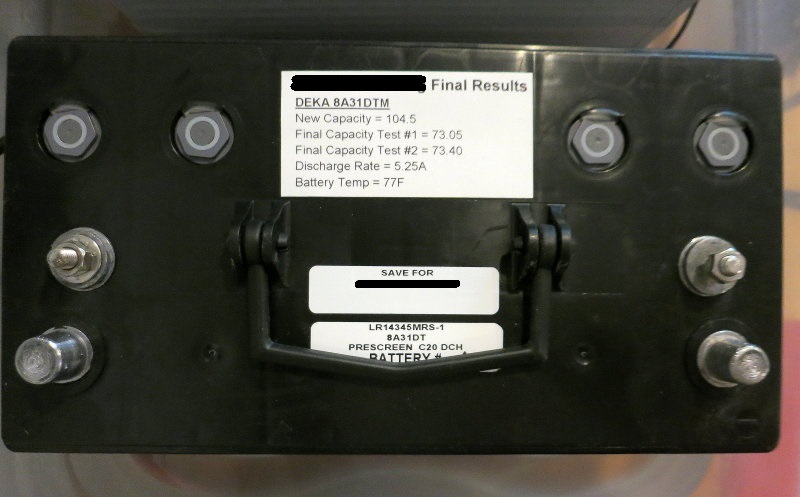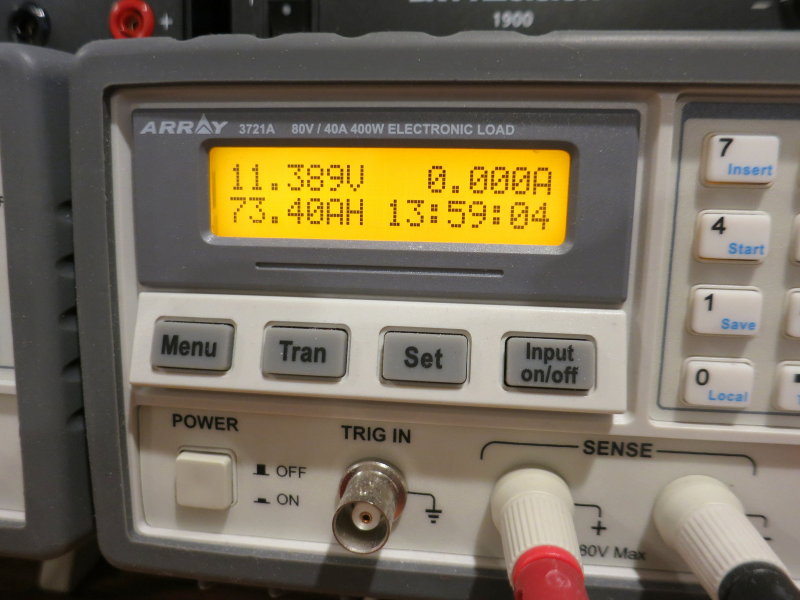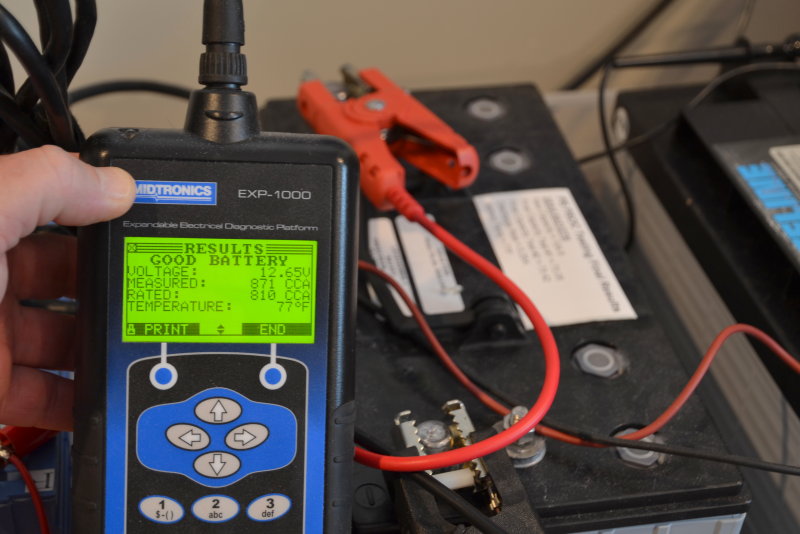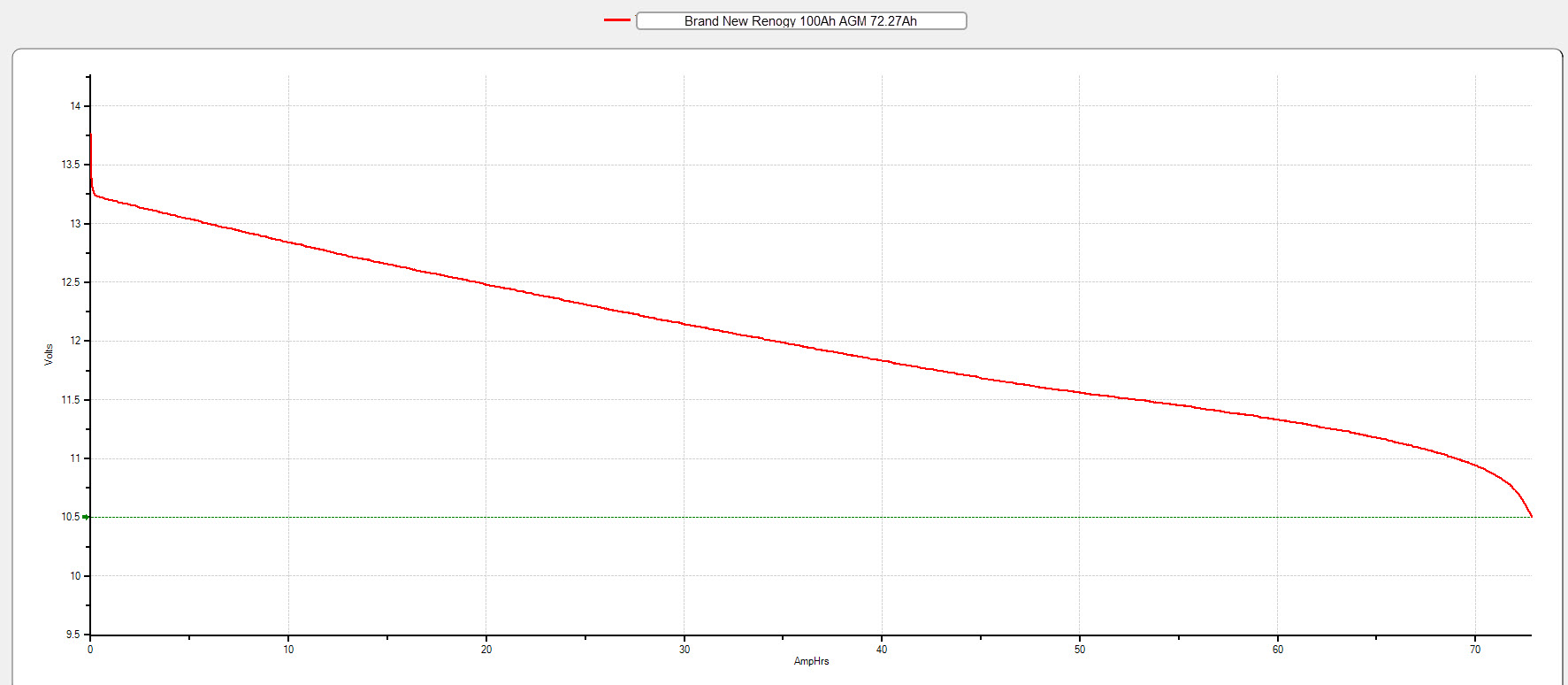20 Hour Capacity Test Results

PUBLIC APOLOGY: First let me begin this by eating some public CROW. Over the years I have recommended these testers for boat owners or techs to use, as had the ABYC and other reputable organizations. While I have always maintained a get a baseline > moving forward manner for use, it seems even this may not be as accurate as I had initially thought it was. While this type of use, baseline > forward, may give an indication of changes in the battery they do not easily correlate as well as I initially thought, or was lead to believe by the manufacturers of these products.
It was not until we got heavily involved in actual physical capacity testing (20 hour capacity tests) & reserve capacity or reserve minute testing that I realized the extent of the errors in these devices as related to usable Ah CAPACITY at the loads a boater would normally use. The manufacturers make these testers sound like the second coming of God, and they may be for cranking amps, but they perform rather miserably for translating to SoH or battery state of health based on deliverable Ah capacity.
I am not the kind of guy who likes to mislead folks, so I am just being be honest about our findings. I am also not the kind of guy who, just because he owns something, will insist it is the best. That is not at all my style. I will be honest when things don’t work out as I had hoped, and battery conductance testers are one of those cases where the product does not do what we were led to believe it could..
Conductance Testers Vs. Ah Capacity Testing:
Over the past 5 months I had to opportunity to run hundreds and hundreds of hours of battery testing for one of the sailing publications (Practical Sailor May 2015 & August 2015). That PSOC testing spun off some other interesting tid-bits. What this article will show you is how actual 20 hour Ah capacity tests compare to conductance battery testers. The results are more shocking than you’d probably ever imagine.
For the PSOC partial state of charge cycle testing all the batteries were cycled up to rated capacity and a baseline Ah capacity was established using the average of two controlled 20 hour capacity tests to BCI testing standards. This particular battery, a Deka/East Penn AGM tested new, once “cycled-up” to capacity, at 104.5 Ah’s or just shy of its 105Ah rating.
It should be noted that we conduct 20 hour tests vs. shorter tests, such as a 25A or 75A fixed load reserve capacity test because as a battery ages a high rate discharge test and a 20 hour test begin to diverge. A 20 hour test most closely represents how a boater will actually discharge a house bank and is how the battery got its Ah rating.
For example, when new, cycled, and broken in a Lifeline GPL-31 will deliver 105 Ah’s over 20 hours at a 5.25A load. It can also run for 195 minutes at a 25A load. As this battery ages the 25A load becomes less representative of the actual low-rate usable capacity and a 20 hour test and fixed 25A rate test will deliver differing results. For example at a 20 hour discharge rate the used battery may deliver 83% of its rating and under the 25A load it may only deliver 71% of its rating. How the battery is aging determines how much variation. It can vary widely so we stick with the gold standard 20 hour capacity test.
On boats we discharge house banks at less than the 20 hour rate so the 20 hour test is the most useful and most relative test we have. A 25A test may fail your battery for your typical use before it is really dead for your use. Capacitance testing often over exaggerates your actual state of health, for house bank use, which can lead to dangerous premature failures.
The pictured battery went through some rather brutal PSOC testing and after the PSOC testing, the now diminished tested Ah capacity of this battery was approx 73 Ah’s or a loss of 30% of its usable Ah capacity. The baseline when new was 104.5 Ah’s and during the Practical Sailor PSOC test is sharnk to 73Ah’s.
So how did the conductance testers compare to an actual 20 hour capacity test? You’re about to find out…..
Screen Shot of 20 Hour Results

For capacity testing here at Compass Marine Inc. we use multiple lab grade DC electronic loads, such as the one pictured, as well as a fully computerized DC battery testing stations to apply a constant current at a fixed amperage. The pictured tester is extremely accurate and holds current 100% stable during the discharge process.
Here we are looking at the actual Ah capacity for the battery pictured previously after undergoing the Practical Sailor PSOC testing. Yes, this battery lost nearly 30% of its Ah capacity during this particularly difficult testing.
Midtronics EXP-1000HD Screen Shot

It should be noted that I own and spent my own hard earned money, well Compass Marine’s money, on all the impedance testers used in this article. I first noted these discrepancies years ago, after being urged by the ABYC to own these testers. We tried to draw conclusions that could translate the results from actual Ah capacity to what these devices spit out. It failed. I also spent a great deal of time on the phone with the folks at Midtronics, & Argus, while Argus was still in business, trying to come up with a translation “factor” from CCA or internal resistance to Ah capacity. We tried and tested this for many for different battery types including GEL, Flooded, AGM and TPPL AGM. Suffice it to say there is no translatable calculation that is repeatable and reliable.
The “Gold Standard” for Cranking Batteries:
The Midtronics line of impedance testers are considered the gold standard for cranking capacity testing. Many battery manufacturers, such as Deka supply these testers, at great cost, to their resellers in an attempt to limit warranty replacements. This is great for trucking fleets and automotive applications but early on we was led to believe these could be a good predictor of state of health / SOH for marine batteries too. Midtronics sales engineers even told us this! Boy, was I mislead, at least in regards to Ah capacity, which is what really matters to boaters. This particular tool is a 4 figure product and we use it regularly just not for testing house batteries for SoH. Don’t get me wrong we love this tool, and it serves many other purposes, but predicting Ah capacity or SoH (state of health), as related to usable battery capacity, ummmm…well…..FAIL…….!
The Shocking Results:
So how did it do? As can be seen I accidentally programmed it for 810CCA when the battery is really rated at 800CCA. This really matters little because we are trying to figure out where the testers says this battery is in relation to the factory rating. If I had been printing a test receipt, for a customer, I would have changed it from 810 CCA to 800 CCA but, not a big deal for this.
The Midtronics EXP-1000HD showed this battery performing at approx 109% of its factory rating or BETTER THAN NEW. While this may be true for short duration cranking amps it is an utter failure at predicting usable Ah capacity because we know for a fact this battery is down 30% of its as new factory 105Ah rating at just 73.4Ah’s… Ouch……
Results by the Numbers:
Factory CCA Rating = 800CCA
EXP-1000HD Results = 871CCA
Percentage of Factory CCA Rating = 109%
Factory Rated Ah Capacity = 105 Ah
New Tested Ah Capacity = 104.5 Ah
Actual Ah Capacity When Compared to Midtronics = 73.40 Ah
For fairness this battery was still in our water-bath which is used to control battery temp to 77F during testing. The Midtronics measures battery temp as can be seen from the screen shot and the battery is at 77F just as it should be for a 20 hour capacity test..
Argus 500 Screen Shot

Next up is the Argus 500. Unfortunately Argus does not exist any longer because Midtronics sued them out of business for stealing proprietary patent protected information and using it in the Argus product line. Based on that, it is no surprise at all that the Argus came it with a 1 CCA difference of the Midtronics or 870 CCA vs. 871 CCA.
Results by the Numbers:
Factory CCA Rating = 800CCA
Argus 500 Results = 870CCA
Percentage of Factory CCA Rating = 109%
Factory Rated Ah Capacity = 105 Ah
New Tested Ah Capacity = 104.5 Ah
Actual Ah Capacity When Compared to Argus = 73.40 Ah
Results for comparing Ah capacity to CCA = FAIL!
Centech Screen Shot

Just for grins I was in Harbor Freight one day and grabbed the Centech conductance tester. It was under $100.00 but is, shall we say, horribly sloppy when compared to the gold-standard Midtronics or to the Argus.
In this shot the Centech/HF tester is making this very tired battery appear to be a rock star. A battery that is down 30% of its factory rated Ah capacity is anything but a “rock star”. In fact, a battery that can no longer deliver 80% of its factory Ah rating is considered dead by industry standards! If buyers of this tester believe it to be true for SoH their actual Ah capacity could be extremely misleading, much more misleading than the Midtronics.
Results by the Numbers:
Factory CCA Rating = 800 CCA
Centech Results = 1018 CCA
Percentage of Factory CCA Rating = 127%
Factory Rated Ah Capacity = 105 Ah
New Tested Ah Capacity = 104.5 Ah
Actual Ah Capacity When Compared to Centech = 73.40 Ah
Results for comparing Ah capacity to CCA = FAIL!
In all honesty I did believe I could learn to translate the impedance/CCA data to Ah capacity but every time I though I had it nailed, a curve ball was thrown.
Bottom Line?
Save your money unless all you need is cranking capability!
- If you want to know the cranking ability of a battery, the Midtronics testers can be useful.
- If you want to know your batteries SoH, as related to Ah capacity, fogedaboutit.
So how can you use one if you already bought it? I still suspect we can draw some conclusions from an initial baseline to a future test using the same tester and the same batteries. I have developed lots of these sorts of data-sets for our Argus and Midtronics testers, but they keep proving us wrong and this is very, very frustrating. IF we figure out a translation and think we nailed it we get thrown a curve ball on the next battery.
The bottom line is that impedance/conductance testers simply do not translate to SoH for usable Ah capacity. For deep-cycle house banks Ah capacity or usable Ah capacity is all that matters. I certainly wish they were more accurate because it would make our life much, much easier.
I have no qualms with the Midtronics tool for predicting cranking capacity, and suspect it is rather accurate. If buying a conductance tester, for cranking testing, the only one we recommend is the Midtronics line or a company that licenses with Midtronics for its technology.
The slew of Chinese testers out there are pure unadulterated crap. We have now tested about 8 different Chinese testers and not a single one comes anywhere close to the Midtronics. The Harbor Freight / Centech is not worth the cardboard box it ships in. Garbage data is garbage data.
The Only Test for Deep-Cycle Batteries = 20 Hour Discharge Test
The 20-hour test below was a brand new 100Ah AGM battery bought off the internet. The customer used them for two-nights and suspected something was wrong. He brought them to us for testing and the most battery #1 could deliver was 72Ah (shown below) & battery #2 was 76Ah…
The best value capacity tester by far is the West Mountain Radio CBA-V.

